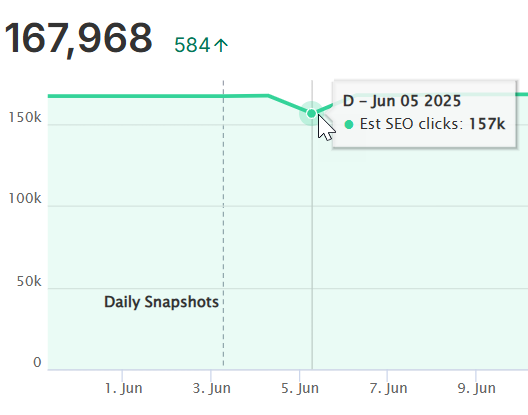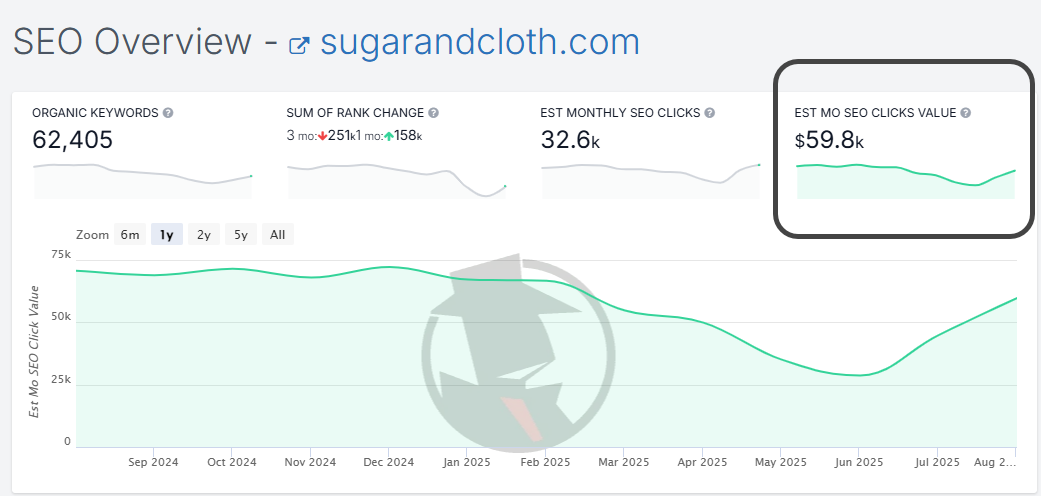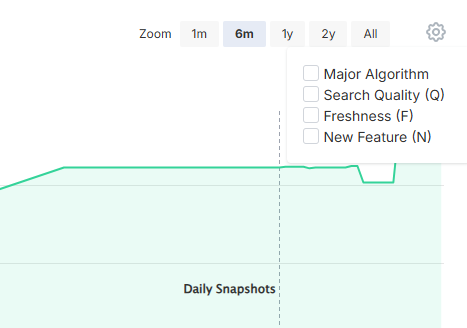You can check a website's traffic to measure a competitor, research a potential client, or track trends in an industry. Tools like SpyFu let you see how many people are clicking through to their website, which keyword searches get them noticed, and which pages from their website are ranking in Google search results.
How to Check a Website's Traffic
Search the website's name into the SpyFu search bar.

What to Look For
The first results show you an overview that includes a traffic comparison of organic traffic vs. paid traffic.

The number of clicks tells you how many visitors made it from a Google search results page to the website during the most recent month.
On SpyFu, that top section breaks down SEO traffic on the left and paid traffic on the right. Here's how to learn how much traffic a website is getting from either channel:
How to Check a Website's SEO Traffic
A site's SEO traffic is an estimate of how many visitors they got from just their Google organic results.

What to Look For
You can see the organic traffic on that first SpyFu results page, but there are more options if you click through to get more details on the SEO Overview page.
How do you know how much traffic a website gets?
Traffic estimators use different (and usually complex) methods to get closer to a website's visitor count, but generally it calculates all of the search engine results that the site appears on--thanks to its individual pages--and the rate that people click those different results.
They factor in keyword rankings, search volume, and estimated click-through rates to approximate how much traffic a site might be getting.
Compare their SEO Traffic to a Competitor's Traffic
You can also check a website's organic traffic against its biggest competitors. This chart shows you the share of traffic across similar websites.

Go to the SEO Overview on SpyFu and scroll down to the Competitors Section. You can edit the listed competitors--even adding more to the list--to see their traffic share by comparing clicks, or compare their keyword count.
How to Check a Website's PPC Traffic
Many websites pull in traffic through paid ads. Google Ads accounts for a massive portion of search advertising, and you can check a site's Google Ads paid traffic through SpyFu's PPC Overview.

What to Look For
The monthly PPC clicks metric gives you a sense of how many people landed on their website after seeing one of their Google search ads. Websites bid on keyword searches so that their ad pops up with the results.
As with SEO traffic, a site's paid traffic is an estimate. Google does not share the exact number of clicks that an advertiser gets. The advertiser itself can measure that through their own Google Analytics.
How to Check a Website's Daily Traffic
If you have a little more interest in a website--it's a client, your own site, or a direct competitor--you might want to watch for fluctuations in their daily website traffic. You can track that by adding that website to the My Sites feature on SpyFu.

Once you start tracking a website through My Sites, it shows you more frequently updated metrics, including traffic changes throughout the day. That's marked as "Daily Snapshots" on the chart.
The overall count indicates the domain's monthly clicks, but the data points get updated daily. You can check any time to see how daily traffic changes. For instance, look at the chart around June 5 where the day's clicks dropped. With such a low daily click count, the website was on track to get closer to 157,ooo visitors if that trend kept up. It picked back up the next day.

You can see organic clicks (traffic), keyword counts, and average position for each website.
Free Website Traffic Checker
You can check any website's traffic for free via SpyFu. There are no limits to the number of searches you can do for free. Just follow the steps at the start of this guide for Check a Website's Traffic, Check a Website's SEO Traffic, or Check a Website's PPC Traffic. Only Daily Traffic (via My Sites) requires a paid subscription.

A Recap of What You Can Find
SpyFu's website search shows you these traffic-related metrics:
- Estimated number of clicks to the website from SEO results
- Change from last month's estimated traffic
- A display of how much of their SERP traffic comes from SEO over PPC
- Historical website traffic from past months
- Estimated number of clicks to the website from paid Google Ads
SpyFu SEO Overview for a website shows you these traffic-related metrics:
- Estimated organic traffic (via clicks)
- Number of keywords that drive organic traffic
- Value of the clicks that they get from organic traffic
SpyFu PPC Overview for a website shows you:
- Estimated paid traffic (via clicks)
- Number of keywords that drive paid traffic
- Paid ads budget
SpyFu My Sites shows you:
- Estimated daily traffic (via clicks) as part of the monthly traffic rollup
- Traffic changes over time, often for the website's entire history
- Top pages that bring in the most traffic for the website
- Top keyword searches that bring up that website on their search results
More Questions about a Website's Traffic
How Accurate are 3rd Party Traffic Checkers?
Third-party tools do a solid job of estimating website traffic, but their numbers won’t always match what you’d see in a site’s internal analytics platforms like Google Search Console or Google Analytics.
Unless the site owner has granted you permission to those tools, you cannot access another website's first-party data. That is what makes third-party traffic checkers so popular.
While they can't provide a perfect headcount, they offer one of the most reliable ways for anyone (without insider access) to size up organic and paid traffic trends. The estimates are typically close enough to spot big changes, identify leaders in a market, or catch trends over time—perfect for competitive research and quick comparisons.
How Can I Tell Where Their Traffic is Coming From?
When you pull up a website’s profile, you can change the country selection in the search bar to find the traffic count (estimated SEO clicks) from organic searches in that region.
You can tell if a site is mostly attracting a U.S. Audience, has growing visibility in Canada and the UK, or is popular across several continents.
- Compare markets: Spot whether your competitor’s growth is just local or if they’re gaining traction internationally.
- Strategic decisions: Use these insights to decide where to expand your ad targeting or dig deeper into new markets.
By understanding the geographic distribution of a website’s visitors, you can better size up the site’s reach, discover new competitor strongholds, or zero in on untapped markets for your business.
How Can I Evaluate the Value of Their Traffic?
To get a sense of the site's traffic value, look at the estimated click value. The closest comparison to that metric is estimating what it would cost to buy that same traffic through paid ads.

If a website ranks for keywords that advertisers are willing to pay a premium for, that organic traffic is especially valuable. This insight can help you gauge not just how much traffic they're getting, but how much that traffic might be worth to the business.
Track the Impact of Google Updates on Your Site
If you’re curious about how recent Google algorithm changes are affecting your site, SpyFu makes it easy to spot patterns. You can toggle "on" markings for major Google updates on the traffic charts shown above.

These markers align with traffic data on the timeline, so you can match dips or spikes in your clicks to the timing of a specific update.
For example, if your site's traffic dropped sharply right after a known Google update, there's a good chance the update played a role.
What about AI Overviews Affecting My Traffic?
AI platforms and AI overviews (like on Google's search results pages) have noticeably affected website traffic across industries. Though the impact changes from one type of business to another, zero-click searches are designed to give the searcher their answer right on the results page. This keeps them to visiting the website for a quick response.
Many websites started to show a drop in their traffic since the wider roll-out of AI overviews in May 2024.

